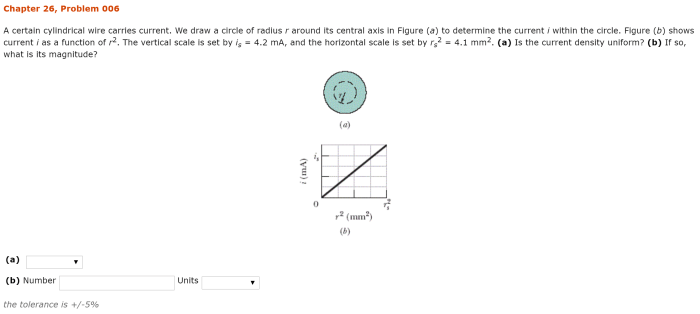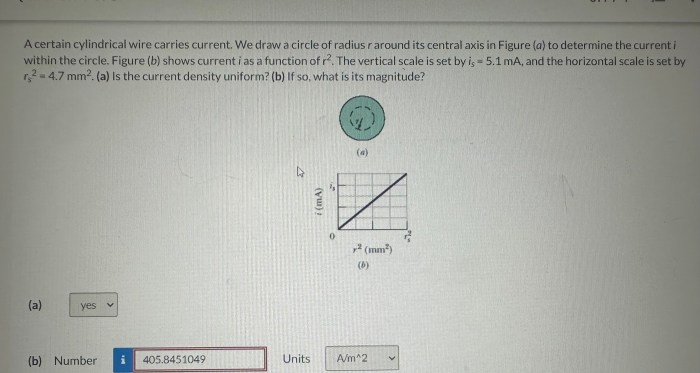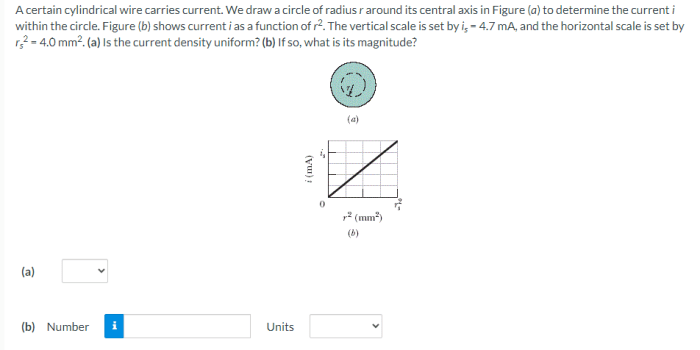A certain cylindrical wire carries current, embarking on a journey that unravels the intricacies of electrical phenomena. This captivating exploration delves into the concepts of current density, resistance, power, magnetic fields, and their practical applications, providing a comprehensive understanding of the fundamental principles governing electricity.
As current flows through the wire, it creates a fascinating interplay of physical properties, shaping the electrical landscape around it. The interplay of these properties forms the cornerstone of numerous technological advancements, making this topic not only academically enriching but also practically relevant.
Current Density

Current density is a measure of the amount of current flowing through a given cross-sectional area of a conductor. It is defined as the current per unit area and is typically expressed in amperes per square meter (A/m 2).
The current density can be calculated using the following formula:
J = I/A
where:
- Jis the current density (A/m 2)
- Iis the current (A)
- Ais the cross-sectional area (m 2)
The current density is affected by a number of factors, including the material of the conductor, the temperature, and the presence of a magnetic field.
Resistance
Resistance is a measure of the opposition to the flow of current in a conductor. It is defined as the ratio of the voltage across a conductor to the current flowing through it and is typically expressed in ohms (Ω).
The resistance can be calculated using the following formula:
R = V/I
where:
- Ris the resistance (Ω)
- Vis the voltage (V)
- Iis the current (A)
The resistance is affected by a number of factors, including the length of the conductor, the cross-sectional area, and the material of the conductor.
Power: A Certain Cylindrical Wire Carries Current

Power is a measure of the rate at which electrical energy is transferred. It is defined as the product of the voltage and the current and is typically expressed in watts (W).
The power can be calculated using the following formula:
P = VI
where:
- Pis the power (W)
- Vis the voltage (V)
- Iis the current (A)
The power is affected by a number of factors, including the voltage, the current, and the resistance of the conductor.
Magnetic Field

A magnetic field is a region of space around a magnet or current-carrying conductor in which magnetic forces can be detected. The magnetic field is created by the movement of charged particles and is typically represented by magnetic field lines.
The magnetic field around a current-carrying wire is proportional to the current flowing through the wire and is inversely proportional to the distance from the wire.
The strength of the magnetic field is affected by a number of factors, including the current flowing through the wire, the distance from the wire, and the presence of other magnetic fields.
Applications
Current-carrying wires are used in a wide variety of applications, including:
- Electrical wiring
- Power transmission
- Motors
- Generators
- Transformers
Current-carrying wires have a number of advantages over other methods of transmitting electrical energy, including:
- They are relatively inexpensive to produce and install.
- They are efficient at transmitting electrical energy over long distances.
- They are reliable and have a long lifespan.
However, current-carrying wires also have a number of disadvantages, including:
- They can be a source of electrical interference.
- They can be dangerous if not properly installed and maintained.
- They can be unsightly.
Commonly Asked Questions
What is current density?
Current density is a measure of the amount of current flowing through a given cross-sectional area of a conductor.
How is current density calculated?
Current density is calculated by dividing the current flowing through the conductor by the cross-sectional area.
What factors affect current density?
Current density is affected by the material of the conductor, the temperature, and the magnetic field.